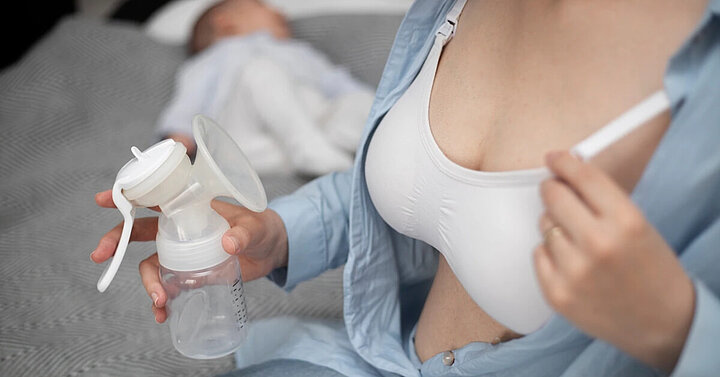How to store and express breastmilk
Feeding | | HiPP Organic
Are you a new mum struggling to efficiently pump breastmilk? Or maybe you're an experienced mama looking for tips to improve your pumping game. Whatever the case may be, this guide is here to help. In this blog post, we'll discuss everything from choosing the perfect pump to maximising your milk output.
What is breastmilk expressing?
Breastmilk expressing is the process of extracting milk from the breasts for the purpose of storing and feeding it to an infant at a later time. There are many reasons why mums may want to express milk, including:
- To provide milk for the baby whilst away
- To increase milk supply
- To relieve engorgement or discomfort
- To donate milk to others in need
There are several ways to express breastmilk, but the most common method is using a pump. Electric pumps are available for purchase and many hospitals provide electric pumps too. The type of pump you use will depend on your personal needs and preferences. Some are now designed to be portable and wearable, offering mums a lot of freedom. You might want to do some research before making a purchase; there are many options.
How to pump breastmilk efficiently
Pumping breastmilk can sometimes feel like a bit of a chore – especially when you are tired and already feeding a lot. With a little bit of planning and preparation, you can make pumping breastmilk more efficient and less time-consuming.
Here are some tips for how to pump breastmilk efficiently:
- Invest in a quality electric breast pump. This will save you time and energy compared to using a manual pump. Or a portable pump you can wear in your bra.
- Pump at regular intervals throughout the day. This will help maintain your milk supply and make pumping more efficient.
- Store your pumped milk in airtight containers in the fridge or freezer. This will help keep it fresh and prevent waste. Some pumps even enable you to pump directly into the storage bag.
- Make sure you are comfortable before starting. In the early weeks you may want to pop a warm flannel on your breasts beforehand to help with milk flow.
- Use hands-on pumping techniques. Gently massaging your breasts while you pump can help increase milk production and flow, making pumping more efficient.
Alternatives to breastmilk expressing
There are a couple of alternatives to expressing breastmilk, which include:
- Hand expression: This is a method of expressing milk without the use of any devices. It can be done anywhere, at any time, and is great for relieving a bit of engorgement too. To hand express, cup your breast with your hand and use your thumb creating a C shape and first two fingers to press in and back towards the chest wall in a rhythmic motion. Milk will start to trickle out. If not, try doing this in a different area but do be gentle with yourself and your body. When the flow from one breast has slowed, swap to the other breast. Keep changing breasts until your milk drips very slowly or stops altogether.
- Power pumping: Power pumping is a method of pumping for a short period of time (usually no longer than 15 minutes) at high frequency (usually every 2-3 hours). This technique can help increase milk production for mothers who have difficulty expressing enough milk.
How to safely store breastmilk
To ensure that your breastmilk is safe for your baby to consume, it is important to take some precautions when storing it. Here are some tips on how to safely store breastmilk:
- In the fridge for up to 8 days at 4C or lower (you can buy fridge thermometers online) – if you're not sure of the temperature of your fridge, or it is higher than 4C, use it within 3 days
- For 2 weeks in the ice compartment of a fridge or for up to 6 months in a freezer, if it's -18C or lower
- Breast milk that's been cooled in the fridge can be carried in a cool bag with ice packs for up to 24 hours.
Store breast milk in small quantities to help avoid waste. If you're freezing it, make sure you label and date it first.
Defrosting frozen breast milk
First, only defrost the amount of milk you think your baby will need for one feeding. If you prepare more than that, it must be used within 24 hours or thrown away. Second, avoid using hot water or microwaves as this can damage the delicate nutrients and antibodies present in breast milk. Instead, run cold water over the frozen bag of milk until it is thawed enough to pour into a bottle. Or even better, if you have time, slowly defrost in the fridge first. You can then warm the bottle under hot running water before serving. Do no re-freeze milk that has been defrosted.
Breastfeeding is a beautiful and rewarding experience for both mother and baby. Expressing your breastmilk can be an efficient way to ensure that your baby is getting the nutrition they need while allowing you to take breaks, go out of town, or return back to work.
There are many methods available for expressing and storing breastmilk. We hope this guide has been helpful in providing useful tips on how to safely express your breastmilk efficiently so that you can maintain a healthy breastfeeding relationship with your little one. If you need further support remember you can always call the National Breastfeeding Helpline on 0300 100 0212 (9.30am to 9.30pm daily).


